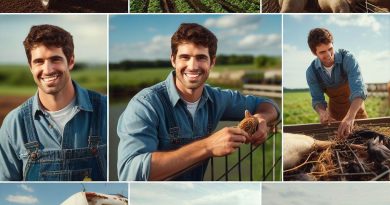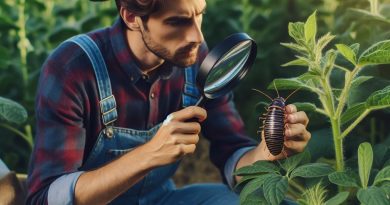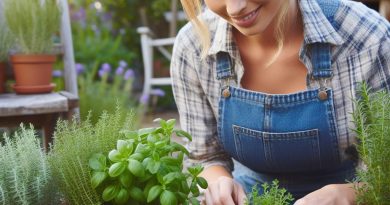From Seed to Table: A Day with Paul
Last Updated on February 21, 2024
Introduction
Meet Paul, a key figure in the farming industry, shaping the journey from seed to table.
Today, we embark on a day-in-the-life journey with Paul, gaining insights into the intricate farming process.
Understanding the process, from seed to table, is vital to appreciate the effort behind our daily sustenance.
Paul’s role extends beyond the fields; he’s a steward of the land, dedicated to providing fresh, wholesome produce.
In this blog post, we immerse ourselves in Paul’s world, discovering the labor and passion that sustains us.
Paul’s commitment to sustainable farming practices is reflected in every step of the process, ensuring quality and environmental consciousness.
As the sun rises, Paul begins his day, tending to the crops with care and precision.
Seeds planted with hope grow under Paul’s watchful eye, evolving into vibrant, nutritious produce.
We follow him through the fields, witnessing the dedication it takes to nurture each plant.
Harvesting becomes a rhythmic dance, as Paul gathers the fruits of his labor, a culmination of hard work.
The journey continues to the market, where Paul’s produce finds its way to our tables, a testament to the farm-to-table ethos.
Through this day-in-the-life experience, we connect with the source of our food, appreciating the human touch behind every meal.
Join us on this exploration of Paul’s world, where the journey from seed to table comes to life, enriching our understanding of sustainable farming.
Morning Schedule
Paul’s early morning routine on the farm
Waking up at the crack of dawn
Paul’s day on the farm starts bright and early, as he rises from his bed at the crack of dawn.
Waking up with the sun, Paul embraces the quiet serenity of early morning, a moment of reflection.
Checking weather reports and planning the day’s tasks
Before even having breakfast, Paul grabs his phone and checks the latest weather reports for the day.
He then plans his tasks accordingly, ensuring that everything runs smoothly on the farm.
With a steaming cup of coffee in hand, Paul reviews the tasks for the day, orchestrating the symphony of the farm.
As he sips, he contemplates the delicate balance between nature’s unpredictability and the farm’s meticulous planning.
Stepping outside, the cool morning air greets Paul as he heads towards the fields, a canvas awaiting the day’s artistry.
Walking through the fields to assess crop growth
With a hat firmly on his head and a notepad in hand, Paul walks through the fields to assess the growth of the crops.
He carefully inspects each plant, noting any signs of pests or disease and contemplating the best actions to take.
Read: Family Farm Life: The Smiths’ Tale
Planting and Tending the Crops
Planting and tending the crops are crucial stages in the journey from seed to table. These stages determine the success and quality of the final harvest.
In this section, we will delve into the different stages of planting and the importance of crop maintenance.
Different stages of planting
The first stage of planting starts with prepping the soil. Before planting, it is essential to ensure that the soil is in optimal condition.
This involves removing weeds, rocks, and debris, and loosening the soil to promote better root growth. Suitable fertilizers are also added to provide the necessary nutrients for the plants.
Once the soil is prepped, the next stage is carefully selecting and planting the seeds. This involves choosing high-quality seeds that are suitable for the desired crop.
The seeds are then planted at the appropriate depth and spacing, ensuring they have enough room to grow and develop.
The importance of crop maintenance
Crop maintenance plays a vital role in ensuring healthy plant growth and minimizing potential yield loss. Here are some key aspects of crop maintenance:
Irrigation and watering techniques
Proper irrigation and watering techniques are essential to provide the plants with adequate moisture. This helps in seed germination, promotes root development, and ensures overall plant health.
Farmers must adjust the irrigation schedule based on the crop’s water requirements and environmental conditions.
Weed control and pest management
Weeds compete with crops for resources such as sunlight, water, and nutrients. Effective weed control methods are crucial to prevent weed growth from inhibiting crop growth.
This can be achieved through manual removal, mulching, or the use of herbicides.
Similarly, pest management strategies must be implemented to protect crops from harmful insects, diseases, and pests.
Monitoring growth and adjusting strategies accordingly
- Regular monitoring of crop growth is essential to identify any issues or challenges.
- Farmers need to observe the crop’s progress, check for signs of nutrient deficiencies or pest infestations, and make necessary adjustments to cultivation strategies.
- This may involve adjusting irrigation schedules, applying additional fertilizers, or implementing pest control measures.
The successful journey from seed to table involves careful planting and tending of crops.
Prepping the soil, selecting high-quality seeds, and providing optimal crop maintenance are all significant factors in achieving a bountiful harvest.
It is crucial for farmers to effectively manage irrigation, weed control, and pest management while continuously monitoring plant growth and making necessary adjustments.
By following these stages and practices, farmers can ensure the growth of healthy and nutritious crops that eventually reach our tables.
Read: Farm Innovations: Alex’s High-Tech Field
Harvesting and Gathering
Paul’s Process of Identifying When Crops are Ready for Harvest
- Paul identifies when crops are ready for harvest by observing visual cues and plant maturity.
- He also checks for proper moisture levels to ensure the crops are at their peak.
Techniques Used for Harvesting Different Crops
- For delicate fruits and vegetables, Paul prefers the method of handpicking to avoid damaging them.
- In the case of large-scale harvesting, he utilizes machinery to increase efficiency and productivity.
The Importance of Careful Handling and Minimizing Waste During the Gathering Process
During the gathering process, careful handling and minimizing waste are crucial for optimal results.
- With careful crop handling, Paul ensures higher-quality produce, minimizing waste and promoting sustainable practices.
- Paul trains his staff in proper handling techniques, emphasizing efficiency, and sorting processes for top-quality crops.
- Avoiding unnecessary roughness and using appropriate tools are fundamental in reducing damage and maximizing market value.
- Emphasizing staff training and efficient sorting, Paul ensures only the freshest, highest-quality produce reaches consumers.
- Storage techniques and repurposing unsuitable crops for compost or feed are key strategies in minimizing waste.
- Paul’s commitment not only saves money but also positively contributes to environmental conservation by reducing greenhouse gas emissions.
Overall, Paul understands that careful handling and minimizing waste are essential components of the gathering process.
His dedication to these practices ensures that his farm produces high-quality, sustainable, and marketable crops.
Read: The Local Food Hero: Emily’s Story

Processing and Packaging
After the crops are harvested, the next crucial step is processing and packaging.
These steps play a significant role in ensuring the quality and freshness of the produce as it makes its way from the farm to your table.
Steps Taken to Process Harvested Crops
Firstly, the harvested crops undergo thorough cleaning and sorting. This process involves removing any dirt, dust, or impurities that may have accumulated during the harvest.
It is essential to have clean crops to maintain their quality and prevent contamination.
Once cleaned, the next step is to remove any unwanted parts and debris from the crops. This includes detaching stems, leaves, or any damaged or spoiled portions.
By doing so, only the edible and healthy parts of the crop remain, enhancing the overall quality.
After the crops have been cleaned and unwanted parts removed, they go through grading and sorting. Grading involves categorizing the produce based on its size, shape, color, and other quality attributes.
This step ensures that only crops meeting the desired standards are packaged and sold, allowing consumers to enjoy fresh and top-notch produce.
Packaging Methods for Storing and Transporting Crops
- Once the processing steps are complete, it’s time to package the crops for storage and transportation.
- Packaging plays a crucial role in protecting the crops and extending their shelf life. Containers, such as plastic or wooden crates, are commonly used for fruits and vegetables.
- These containers help prevent damage during handling and ensure the produce remains intact.
- For smaller crops like berries or herbs, specialized bags or clamshells may be used to maintain their freshness.
- These packaging methods not only protect the crops but also make them more convenient for consumers to handle and store at home.
- Proper labeling is an important aspect of packaging. Each package needs to be clearly labeled with necessary information such as the crop type, harvest date, and origin.
- This information ensures traceability and allows consumers to make informed choices about the products they purchase.
- Additionally, labels may include nutritional information, certifications, or any specific handling instructions.
- Maintaining traceability through proper labeling establishes transparency in the supply chain and helps address any potential food safety concerns or recalls.
- It also enables consumers to support local or sustainable farming practices if they prefer.
The processing and packaging steps are crucial in ensuring the quality, safety, and longevity of harvested crops.
Cleaning, sorting, and grading contribute to the overall quality control, allowing only the best produce to reach consumers.
Packaging methods involving containers, crates, or bags protect the crops during storage and transportation.
Proper labeling ensures traceability and consumer awareness, fostering transparency in the food supply chain.
Delivery and Distribution
When it comes to getting fresh, quality crops from the farm to the consumer’s table, a well-managed delivery and distribution process is crucial.
Let’s take a closer look at the journey these crops go through and the importance of efficient logistics and timely deliveries.
Journey of crops from the farm to the consumer’s table
The journey begins with the transportation of crops from the farm to distribution centers or local markets.
This step involves careful planning and coordination to ensure that the crops reach their destinations in the freshest possible state.
Farmers often work with transportation companies that specialize in agricultural products to ensure smooth and efficient delivery.
Once the crops arrive at distribution centers or local markets, collaboration with wholesalers, retailers, and restaurants becomes essential.
Wholesalers typically purchase large quantities of crops from the farmers and then distribute them to retailers and restaurants.
Retailers, in turn, make these crops available to consumers through their stores, while restaurants use them as ingredients for their dishes.
Effective collaboration between these entities ensures that the crops are properly handled and reach the consumers promptly.
Throughout the delivery and distribution process, food safety and quality standards play a vital role.
Farmers, transportation companies, wholesalers, retailers, and restaurants must adhere to strict guidelines to ensure that the crops are handled and stored properly.
This includes maintaining proper temperature control, managing pest control, and following hygiene practices to prevent contamination.
Regular inspections and certifications help to maintain the highest level of food safety and quality throughout the supply chain.
Importance of efficient logistics and timely deliveries
Efficient logistics and timely deliveries are crucial aspects of the delivery and distribution process. Every step, from harvesting the crops to delivering them to consumers, must be carefully planned and executed.
Efficient logistics ensure that the crops are transported using the most cost-effective and time-efficient methods. Timely deliveries are essential to maintain the freshness and quality of the crops.
Consumers expect to receive fresh produce, and any delivery delays can result in spoilage and dissatisfaction.
One important aspect of efficient logistics is the use of advanced technology and tracking systems.
This allows farmers, transportation companies, and other stakeholders to monitor the movement of crops at every stage.
Real-time information helps identify potential issues and allows for quick adjustments to ensure timely deliveries.
In essence, the journey of crops from the farm to the consumer’s table relies on an efficient delivery and distribution process.
Transporting crops to distribution centers or markets, collaborating with wholesalers, retailers, and restaurants, and ensuring food safety and quality standards are integral to this process.
Efficient logistics and timely deliveries are essential to maintain the freshness and quality of the crops. By focusing on these aspects, we can ensure that everyone can enjoy farm-fresh produce on their tables.
Read: Farm-to-Fork: Jane’s Organic Practices
Conclusion
From seed to table, Paul’s journey illuminates the intricate process of sustainable farming, nourishing communities.
Paul’s meticulous care from planting to harvest ensures the freshest, highest-quality produce for consumers’ tables.
His dedication, from assessing crop growth at dawn to implementing waste-reducing techniques, exemplifies sustainable farming principles.
We extend gratitude to farmers like Paul, whose hard work sustains us with wholesome, locally grown food.
Their dedication not only feeds communities but also nurtures environmental stewardship and supports local economies.
As consumers, it’s essential to recognize the value of local farming initiatives like Paul’s and actively support them.
By choosing locally grown produce, we contribute to vibrant, resilient communities and sustainable food systems.
Let’s cultivate appreciation for the labor and dedication of farmers like Paul, who tirelessly nurture our food sources.
In supporting local farming initiatives, we foster a deeper connection to the land and the food we consume.
Together, let’s celebrate the journey from seed to table and honor the farmers who make it possible.


